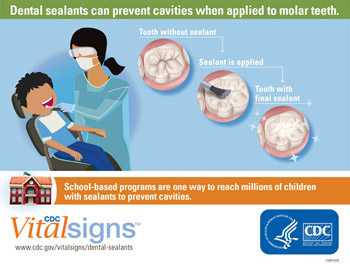School dental-sealant programs could prevent most cavities, lower treatment costs in vulnerable children
Press Release
Embargoed Until: Tuesday, October 18, 2016, 2:00 p.m. ET
Contact: Media Relations
(404) 639-3286
Research shows dental sealants to shield the back teeth could prevent up to 80 percent of cavities in school-aged children. They are quick, easy, and painless to apply – yet according to a new CDC Vital Signs, about 60 percent of school children ages 6-11 years don’t get dental sealants.
Dental sealants are a thin coating that is painted on teeth to protect them from cavities. One way to provide sealants to more children is by increasing their access to school-based sealant programs (SBSPs).
SBSPs are especially important for children from low-income families because such children are less likely to receive dental care. These programs target schools with a high percentage of children eligible for free or reduced-cost meal programs. As a result, SBSPs provide sealants to children who are at higher risk for cavities and less likely to receive preventive care.
“Many children with untreated cavities will have difficulty eating, speaking, and learning,” said CDC Director Tom Frieden, M.D., M.P.H. “Dental sealants can be an effective and inexpensive way to prevent cavities, yet only 1 in 3 low-income children currently receive them. School-based sealant programs are an effective way to get sealants to children.”
School-based dental sealant programs are high impact and low costSealants provided in school settings are effective. Recent studies found that dental sealants prevent 80 percent of cavities for two years after application and continue to protect against 50 percent of cavities for up to 4 years after placement. They can be retained in the mouth for as long as nine years.
Key findings from the report include:
- About 43 percent of 6- to 11-year-old children had a dental sealant. Low-income children were 20 percent less likely to have sealants than higher-income children.
- School-age children without sealants have almost three times more cavities than children with sealants.
- Applying sealants in school-based programs to the nearly 7 million low-income children who don’t have them could save up to $300 million in dental treatment costs.
State officials play an important role in increasing children’s access to school-based dental sealant programs in their states. Officials can:
- Target school-based sealant programs to the areas of greatest need in their state.
- Track the number of schools and children participating in SBSPs.
- Implement policies that deliver SBSPs in the most cost-effective manner.
- Help connect schools with health departments, Medicaid and CHIP offices, community health centers, and dental professionals in the community.
CDC currently provides funding to 21 state public health departments to coordinate and implement school-based and school-linked sealant programs that target low-income children and those who live in rural settings.
To read the entire Vital Signs report, visit: www.cdc.gov/vitalsigns/sealants.
For more information on SBSPs, dental sealants, and CDC’s work, visit: www.cdc.gov/oralhealth.
About Vital SignsVital Signs is a report that appears as part of the CDC’s Morbidity and Mortality Weekly Report. Vital Signs provides the latest data and information on key health indicators: cancer prevention, obesity, tobacco use, motor vehicle passenger safety, prescription drug overdose, HIV/AIDS, alcohol use, health care-associated infections, cardiovascular health, teen pregnancy, food safety, and viral hepatitis.
- Page last reviewed: October 18, 2016
- Page last updated: October 18, 2016
- Content source:
Error processing SSI file


 ShareCompartir
ShareCompartir
